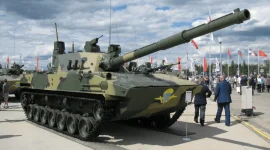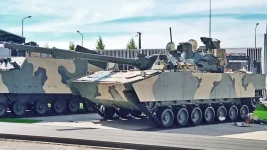- Views: 1K
- Replies: 10
Armoured Vehicles Nigam Limited (AVNL), India's state-owned defence company based in Avadi, Chennai, is advancing a significant project to develop a new generation of light tanks. These vehicles are specifically designed for India's varied and demanding operational terrains, with a particular focus on high-altitude warfare.
In a notable strategic move, AVNL is in discussions with prominent global defence firms, including Belgium's John Cockerill and Israel's Elbit Systems. The collaboration aims to incorporate advanced Western technologies, such as sophisticated command, control, communications, computers, intelligence, surveillance, and reconnaissance (C4ISR) systems, lightweight yet powerful weaponry, and modern survivability features into these future platforms.
This engagement with Western companies marks a shift in approach. Earlier considerations had linked AVNL with Russia’s Rosoboronexport for the 2S25 Sprut-SD light tank. However, the current focus on Western designs indicates a preference for modular, technologically advanced solutions to address India's evolving battlefield needs.
The drive for military modernization in India is shaped by its changing security landscape. Challenges are particularly pronounced along the northern borders with China in high-altitude areas like Ladakh and Arunachal Pradesh, and on the western frontier with Pakistan. The 2020 Galwan Valley incident highlighted the operational necessity for agile and lightweight armoured vehicles.
These platforms must be capable of functioning effectively in rugged, mountainous regions where heavier main battle tanks (MBTs), such as the T-90 Bhishma, encounter mobility challenges. Light tanks, typically weighing under 25-30 tons, offer advantages like rapid deployment, superior manoeuvrability, and the capacity to deliver substantial firepower, making them well-suited for high-altitude combat and quick response situations.
AVNL, formed in 2021 following the corporatization of India’s Ordnance Factory Board, is responsible for manufacturing armoured vehicles and artillery for the Indian Army. Its current initiative to develop a next-generation light tank aligns directly with a 2023 Request for Information (RFI) issued by the Indian Army.
This RFI specified a need for 350 light tanks, each weighing less than 25 tons and optimized for high-altitude operations. Key requirements include the integration of advanced C4ISR capabilities, a 120mm main gun, and modular armour for protection against contemporary threats like drones and anti-tank guided missiles (ATGMs).
The exploratory discussions between AVNL and Western defence leaders like John Cockerill and Elbit Systems underscore a strategic choice for platforms that emphasize technological superiority.
John Cockerill, a Belgian company known for its advanced turret systems, brings expertise in lightweight, high-performance armoured vehicle solutions. Their Cockerill 3105 turret, compatible with a 105mm or 120mm gun, is engineered for integration with modern C4ISR systems, facilitating real-time battlefield awareness and networked combat.
Similarly, Israel’s Elbit Systems is a leader in cutting-edge electronics, offering advanced fire control systems, active protection systems (APS) to intercept incoming threats, and drone countermeasures. This expertise matches India's goals for digitized and interconnected warfare capabilities.
Several key characteristics of Western light tank designs are considered critical by AVNL:
- C4ISR Integration: Modern sensors, communication networks, and artificial intelligence-assisted decision-making tools allow for seamless coordination with other battlefield elements, including drones, artillery, and infantry units.
- Lightweight Firepower: The inclusion of 120mm main guns, coupled with sophisticated fire control systems, offers firepower comparable to main battle tanks but in a significantly lighter and more mobile platform, capable of engaging both armoured and unarmoured targets.
- Enhanced Survivability: The use of composite and modular armour, along with active protection systems, provides defence against a range of threats, including kinetic energy penetrators, chemical agents, ATGMs, and loitering munitions. Modular designs also permit rapid upgrades to counter newly emerging threats.
- Anti-Drone Capabilities: Recognising the growing threat from unmanned aerial vehicles, as reportedly highlighted during recent events such as the "Operation Sindoor" in May 2025, AVNL is prioritising the integration of counter-drone systems. These may include electronic warfare suites and potentially directed-energy weapons.
Previously, reports had suggested that AVNL was close to an agreement with Russia’s Rosoboronexport to produce a version of the 2S25 Sprut-SD locally.
The Sprut-SD is an 18-ton light tank developed for Russia’s airborne forces, featuring a 125mm 2A75 smoothbore gun. It is designed for air-transportability and high mobility, which made it a potential candidate for India’s high-altitude needs.
Its capability to traverse difficult terrain while delivering MBT-level firepower was viewed as a potentially cost-effective option, considering India’s historically strong defence procurement relationship with Russia, which has been a major supplier of its arms imports.


